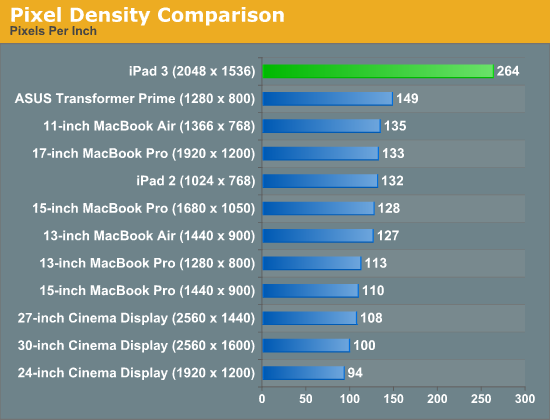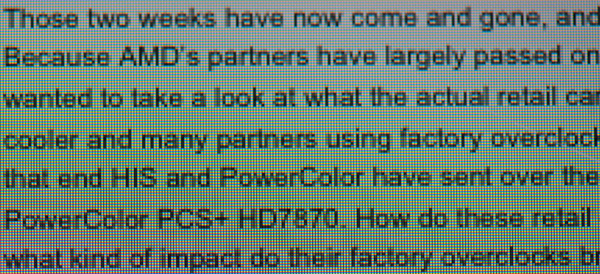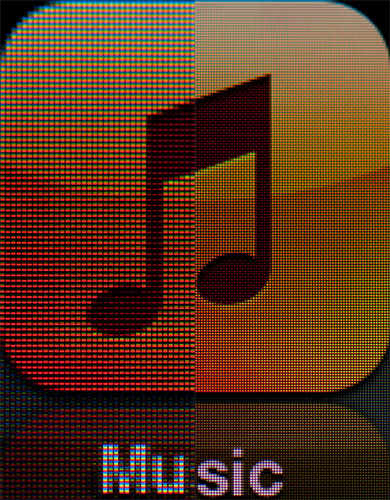The new iPad: Retina Display Analysis
by Anand Lal Shimpi on March 19, 2012 5:49 PM ESTWe're hard at work on our review on the new iPad but with a fair bit of display analysis under our belts I thought a quick post might be in order. One of the major features of the new iPad is its 2048 x 1536 Retina Display. Apple kept the dimensions of the display the same as the previous two iPad models, but doubled the horizontal and vertical resolution resulting in a 4x increase in pixels. As display size remained unchanged, pixel density went through the roof:

Although the iPad 2 has a fairly high pixel density compared to most of Apple's Mac/display lineup, you're more likely to hold a tablet closer to your eyes which made the low resolution/pixel density problematic. The new iPad addresses this issue as you can see from the chart above. I can't focus closely enough to the panel to actually make out pixels on the new iPad, much less at a normal viewing distance. With the aid of a macro lens we can definitely identify individual pixels. The improvement over the iPad 2 display is striking:
To the left we have the original 1024 x 768 panel, and to the right we have the new Retina Display. At this distance you can still identify individual pixels, an ability that quickly vanishes at normal viewing distances. The Music app icon is an even better example of what you gain from the newer display as it has more high contrast edges that appear more aliased on the 1024 x 768 panel:
The old iPad's 1024 x 768 resolution was fairly bothersome when it came to reading text on web pages or books. Most Android tablets standardizing on 1280 x 800 offered an advantage in that respect, albeit not delivering significantly higher pixel density. The new iPad completely resolves this issue. Hover over the links below to see roughly the same paragraph of text from our retail Radeon HD 7870 review on the iPad 2, new iPad and ASUS Transformer Prime:

| Apple iPad 2 | Apple iPad (3rd gen) | ASUS TF Prime |
| original | original | original |
While it's still obvious that you're looking at a screen and not an e-ink display, the pixels perform a good disappearing act on the new iPad.












172 Comments
View All Comments
doobydoo - Tuesday, March 20, 2012 - link
They are 'premium' because they have the longest battery life, highest resolution, best reliability ratings, best customer satisfaction ratings, and by far and away the fastest GPU (over 4x in some benchmarks) when compared to the very best of the rest.If you find a comparable tablet you can describe this one as overpriced. Oh... haters.
gorash - Tuesday, March 20, 2012 - link
You can say the same thing about anything, Transformer Prime, Galaxy Tab, whatever.Transformer Prime... fastest CPU, longest battery with docks, Galaxy Tab 7.7... best screen.
doobydoo - Tuesday, March 20, 2012 - link
You just illustrated the difference.Transformer Prime ..... 4x slower GPU. Not longest battery without being plugged in.
Galaxy Tab, 'best screen' ? Please. That's not a fact at all.
So out of the three examples you gave, for 2 tablets, 2 of them are wrong. That leaves precisely one point you were able to make about the iPad - that it doesn't have the fastest CPU. A point easily debunked by citing the fact that iOS is more heavily optimised and so you don't actually ever feel anything slower due to the CPU. Also iOS is GPU accelerated so the GPU does a lot of the work.
Compare that weak argument to the 5 items I listed, and I could have gone on. You're fighting a losing battle if you're really trying to claim there's a better tablet out there right now.
gorash - Tuesday, March 20, 2012 - link
4x is a stretch, it's more like 2-3x at best. And at native resolution, there's no difference between iPad 3 and iPad 2. And it has 4x the slower CPU than Tegra 3.Please, it has an OLED screen which means it wins by default.
Again with the "iOS is heavily optimized, blah blah blah" myth. It just goes to show that you're yet another blind Apple fanboy.
doobydoo - Wednesday, March 21, 2012 - link
iOS is heavily optimised. Even Google admits that is a large advantage iOS has over Android, which necessarily can never be as tightly coupled to the hardware. The benchmarks for example the GL fill test show over 4x faster in some cases. The iPad also has the capability to render at the lower resolution of the iPad 2 - giving it the choice of either 4x better than Android in FPS, or 4x Android in quality of that FPS. Therefore there clearly is a difference, and to say there isn't is to ignore the quality of the resolution, clearly ridiculous. Your claim that the CPU is 4x slower is simply nonsense, not evidenced by any benchmark anywhere. Just a flat out lie.Comments like 'OLED screen wins by default' aren't logical discussions, particularly when comparing screens with just over 25% of the resolution of the new iPad.
gorash - Wednesday, March 21, 2012 - link
Btw, the latest review on Engadget shows that Galaxy Tab 7.7 has the best battery life by far - by 12 hours :).I don't care what you say, it may be a preference but it is a fact that OLEDs have better response time, color reproduction rate and contrasts than LCDs. FACT.
doobydoo - Thursday, March 22, 2012 - link
The Galaxy Tab 7.7 doesn't have better battery life 'by' 12 hours, it has a 2 hour better battery life 'OF' 12 hours. It is a lower powered, lower sized tablet (7.7 inch screen vs 9.7) and therefore isn't really directly comparable to the Galaxy Tab or the iPad.I will concede the battery life is good though, even taking into account the fact it is a smaller, slower, lower resolution device.
The problem with the Galaxy Tab 7.7 is mainly the fact it stutters with the software it runs.
gorash - Wednesday, March 21, 2012 - link
4x slower CPU is an exaggeration/sarcasm, duh, just like your exaggerated claim of 4x faster GPU.doobydoo - Thursday, March 22, 2012 - link
I'm glad you admit, essentially, that your claim is wrong, and no benchmarks show the CPU being 4x faster.My claim, on the other hand, can be evidenced by some benchmarks:
http://images.dailytech.com/nimage/Tegra3_v_A5X_GL...
gorash - Tuesday, March 20, 2012 - link
Ever notice how you tend to justify everything for Apple? It has a slow CPU... but it's okay, because iOS is so heavily optimized that it doesn't need a faster CPU! Yeah, right. Even if it was, it doesn't help to have a faster CPU.